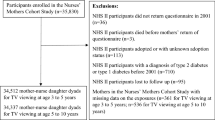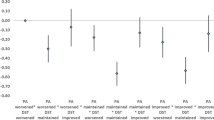Abstract
This study examined the relationship between TV viewing and three year change in BMI among a community-based sample of 176 men, 428 high-income women and 277 low-income women who were aged 20–45 years at baseline. Cross-sectionally, TV viewing was positively associated with BMI among women, but not among men. This relationship was strongest among low-income women, with only a marginal relationship among high-income women. There were no significant relationships between change in BMI and number of hours of TV viewing at baseline, average number of hours of TV viewing over the three year follow-up, or change in number of hours of TV viewing from baseline to three years. These findings suggest the link between obesity and TV viewing is complex, and that TV viewing may not be the simple marker of sedentariness we may have hoped.
This is a preview of subscription content, access via your institution
Access options
Subscribe to this journal
Receive 12 print issues and online access
$259.00 per year
only $21.58 per issue
Buy this article
- Purchase on Springer Link
- Instant access to full article PDF
Prices may be subject to local taxes which are calculated during checkout
Similar content being viewed by others
Author information
Authors and Affiliations
Rights and permissions
About this article
Cite this article
Crawford, D., Jeffery, R. & French, S. Television viewing, physical inactivity and obesity. Int J Obes 23, 437–440 (1999). https://doi.org/10.1038/sj.ijo.0800845
Received:
Revised:
Accepted:
Published:
Issue Date:
DOI: https://doi.org/10.1038/sj.ijo.0800845
Keywords
This article is cited by
-
Do sedentary behaviors mediate associations between socio-demographic characteristics and BMI in women living in socio-economically disadvantaged neighborhoods?
International Journal of Behavioral Nutrition and Physical Activity (2015)
-
Television viewing time and risk of incident obesity and central obesity: the English longitudinal study of ageing
BMC Obesity (2015)
-
Relationship Between Self‐report and an Objective Measure of Television‐viewing Time in Adults
Obesity (2010)
-
Effects of TV time and other sedentary pursuits
International Journal of Obesity (2008)
-
Lifestyle correlates of anthropometric estimates of body adiposity in an Italian middle-aged and elderly population: a covariance analysis
International Journal of Obesity (2006)



